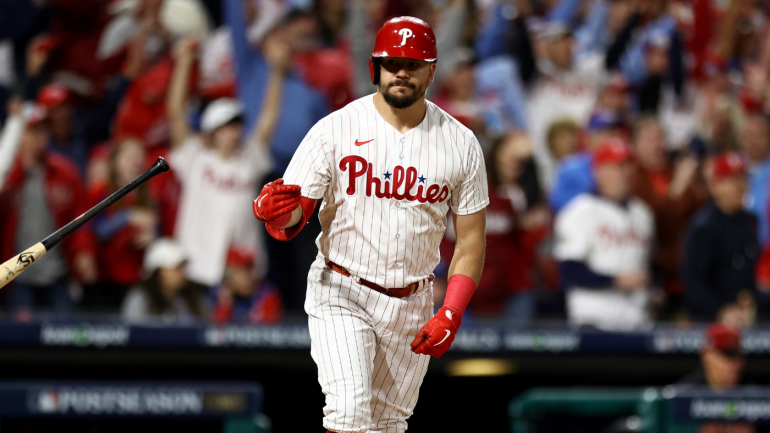
Welcome to Snyder's Soapbox! Here I pontificate about a matter related to Major League Baseball on a weekly basis. Some of the topics will be pressing matters, some might seem insignificant in the grand scheme of things and most will be somewhere in between. The good thing about this website is it's free and you are allowed to click away. If you stay, you'll get smarter, though, that's a money-back guarantee. Let's get to it.
In looking at the final four teams last season, did you notice a similarity in the lineups? What if I pointed out the leadoff men Kyle Schwarber, Marcus Semien, Corbin Carroll (he dropped to second against lefties, but he was the primary Diamondbacks leadoff hitter) and Jose Altuve? We could extend this to other playoff teams with names like Mookie Betts and Ronald Acuña Jr., too.
Yeah, I'm here to say All Hail the Powerful Leadoff Man!
Several years back, I proposed a batting order for Team USA in the World Baseball Classic with Joe Mauer in the leadoff spot. The backlash was immediate and it mainly involved Mauer 1) being a catcher and 2) not being a base-stealer.
How ridiculous of me to suggest that a catcher who doesn't steal bases would ever be a quality leadoff hitter, I heard.
My rationale was pretty simple: it was a lineup full of power hitters and Mauer was the best on-base guy on the team. The formula to scoring runs was to get the leadoff man on base before the thunder. It's such an archaic mindset to believe that we should simply slot the fast center fielder (or middle infielder, but usually just the center fielder) in the leadoff spot.
So many of us remember growing up with the boilerplate batting order through four spots, right?
1. Fast guy, likely CF
2. Most likely a 2B, good bunter
3. 1B, probably
4. Power bat, DH or corner defensive player
Any facet of the game evolves as we start to learn more. First up would be that there's no earthly reason that a position should ever factor in to where a player should bat in the order. Where did this even start? Who the hell cares what defensive position he plays while we're on offense?
Secondly, the lack of efficiency in the above structure is mind-boggling. The leadoff hitter is always going to come to the plate most often, obviously followed by the two-hole hitter. Why are we putting guys there who make more outs than players lower in the order? The early-2000s Moneyball movement helped emphasize on-base percentage at the top of the order and, fortunately, the league has stopped giving away automatic outs in the first inning, for the most part.
Of course, my Mauer-at-leadoff mindset is moving toward becoming archaic, too, if it isn't already there.
The next evolution here is the powerful leadoff man and I can't tell you how much I love it.
Why make it easy on the starting pitcher to start the game? Why not make him deal with the best players right off the bat? If he makes a mistake, it's 1-0 just like that. It's such a big mental advantage in addition to the advantages we can see on the scoreboard, the only real place it matters.
Thankfully, we're getting away from the days of the speedy leadoff man who gets on base about 34% of the time and rarely homers.
Things started to turn, albeit slowly, with the greatest leadoff hitter ever: Rickey Henderson (though we should also give a hat-tip to Bobby Bonds for his powerful exploits from the top in the '70s). In an era when he was supposed to just get on base and run, Henderson clubbed 297 homers. He hit at least 24 three times and had eight 15-plus homer seasons. He was still mostly an outlier. Even Tim Raines, as great as he was, topped out at 18 homers in a season and only got to 15 twice. Sure, there were individual explosions (hello, Brady Anderson) while Alfonso Soriano -- and, to a lesser extent, Grady Sizemore -- had a ton of leadoff power, but a league-wide movement toward powerful leadoff men is a recent thing.
There have been 59 individual seasons with at least 25 homers from the leadoff spot in MLB history and 46 of them came in 2000 or later. Of those, 27 took place in 2016 or more recently. Ten of the 59 have happened in just the last three seasons.
Would you believe this one? Last season, there were three hitters with at least 100 RBI from the leadoff spot. Betts drove home 107, Acuña 106 and Semien 100. The former two players finished in the top two of NL MVP voting and played for 100-win teams. Semien's team won the World Series.
These were the second, third and fourth seasons, respectively, in MLB history in which a leadoff man drove home 100 runs. The first time came from a Rockies player (Charlie Blackmon, 2017), with all of the typical Coors Field asterisks.
Sure, the job still entails getting on base and scoring runs. Acuña scored a ridiculous 149 while Betts scored 126 and Semien scored 122. They did that job with the added element of the power threat. The relatively new component of power in the leadoff spot means the starting pitcher has zero margin for error from the get go and makes every turn of the lineup that much more difficult.
I don't think we necessarily should abandon the need for on-base skills at the top and the baserunning skills from players like Acuña and Carroll are always a plus, but I'm down with the movement toward thunder at the top.
Some will still cling to the decades-old mindset of lineup construction that has the small, light-swinging speedster from center field at the top, but let's move beyond that. All hail the powerful leadoff men! Gimme more like Acuña, Semien, Betts, Springer and Altuve.






















